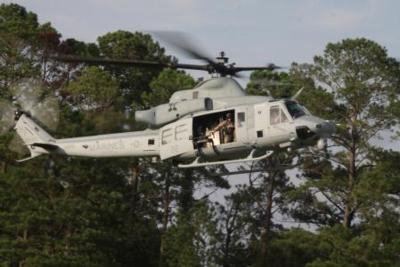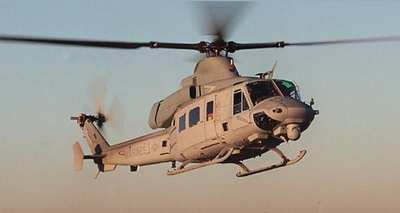Wed, Aug 22, 2012
Training Included Flight Characteristics, Landings In 'Confined Areas'
Marines from Marine Light Attack Helicopter Squadron 269 gained proficiency in the new UH-1Y “Venom” Hueys by practicing flying and landing in confined areas aboard Marine Corps Base Camp Lejeune, August 9. The UH-1Y is the newest model of the Huey, and is commonly referred to as the ‘Yankee’ for the letter ‘Y’ in its designation. It is an upgrade from the older UH-1N ‘November’ version and features many new components.

According to Bell Helicopter, the manufacturer of the Huey, the UH-1Y has almost 50 percent more range and maximum cruise speed than the UH-1N. The Yankee is equipped with a modified four-blade, all-composite rotor and has upgraded engines and transmissions to give it increased payload and performance capabilities. “The Yankee has a lot more power,” said Lance Cpl. Michael J. Costa, HMLA-269 crew chief. “The added power the Yankee has compared to the November allows us to lift more weight and gear.”
To gain experience with the latest model, HMLA-269 used two of their new UH-1Y Hueys to help the pilots and crew maintain their proficiency and learn new tactics from the transition training unit instructors. The two UH-1Ys practiced landing in difficult landing zones where the terrain and obstacles would challenge both the crew and pilots as well as make them more comfortable with the newest variant of the Huey. “The pilots of the Hueys took turns flying into the landing zone and taking off almost immediately after landing, ensuring that both pilots received the best and most amount of training possible,” said Costa.
The Marines returned to Marine Corps Air Station New River to refuel and then performed the same flight and procedures, but during the dark of night.

Since May, the Marines of HMLA-269 began training and transitioning to the UH-1Y, said Lance Cpl. Barry C. Clem, HMLA-269 crew chief. “The West Coast trained with and transitioned to the UH-1Y first,” said Maj. Andrew J. Erickson, Marine Aircraft Group 29 transition training unit instructor. “It takes about 10 months to completely transition a squadron to the Yankee, but now that we have done it so much we have it down to a science.”
“It feels like the transition is going smoother than some of the other HMLA squadrons due to the overall preparedness of the squadron,” said Clem.
(Image provided by the USMC)
More News
Option Approach An approach requested and conducted by a pilot which will result in either a touch-and-go, missed approach, low approach, stop-and-go, or full stop landing. Pilots >[...]
"Emirates is already the world's largest Boeing 777 operator, and we are expanding our commitment to the program today with additional orders for 65 Boeing 777-9s. This is a long-t>[...]
(Pilot) Reported That There Was A Sudden And Violent Vibration Throughout The Airplane That Lasted Several Seconds Analysis: The pilot was returning to his home airport at an altit>[...]
“This recognition was evident during the TBMOPA Annual Convention, where owners and operators clearly expressed their satisfaction with our focus on customer service, and enc>[...]
Overhead Maneuver A series of predetermined maneuvers prescribed for aircraft (often in formation) for entry into the visual flight rules (VFR) traffic pattern and to proceed to a >[...]
 ANN's Daily Aero-Term (11.19.25): Option Approach
ANN's Daily Aero-Term (11.19.25): Option Approach Aero-News: Quote of the Day (11.19.25)
Aero-News: Quote of the Day (11.19.25) NTSB Final Report: Sting Sport TL-2000
NTSB Final Report: Sting Sport TL-2000 Aero-News: Quote of the Day (11.20.25)
Aero-News: Quote of the Day (11.20.25) ANN's Daily Aero-Term (11.20.25): Overhead Maneuver
ANN's Daily Aero-Term (11.20.25): Overhead Maneuver




